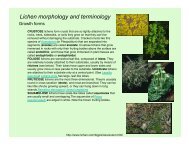Arctic Ecosystems in Russia - Alaska Geobotany Center
Arctic Ecosystems in Russia - Alaska Geobotany Center
Arctic Ecosystems in Russia - Alaska Geobotany Center
You also want an ePaper? Increase the reach of your titles
YUMPU automatically turns print PDFs into web optimized ePapers that Google loves.
ARCTIC ECOSYSTEMS IN RUSSIA<br />
Fig. 16.53. Primary substrate as a result of (A) weather<strong>in</strong>g (Dikson) and (B) water erosion (Rogoz<strong>in</strong>ka River, Taymyr).<br />
formation of the plant cover on "plakor", from the<br />
establishment of the first plants to a close vegetation<br />
carpet. This is possible only <strong>in</strong> typical and<br />
southern tundras (Fig. 16.52).<br />
The first stage<br />
This stage consists of bare ground without macroscopic<br />
physiognomically noticeable organisms<br />
— surfaces that appear as a result of the retreat of<br />
the sea (such areas now exist <strong>in</strong> the Novosibirskiye<br />
archipelago on the Zemlya Bunge). They also<br />
appear because of the retreat of glaciers (on Severnaya<br />
Zemlya and on Zemlya Frantsa-Iosifa) or are<br />
formed as a result of a slipp<strong>in</strong>g and swell<strong>in</strong>g up of<br />
the ground, snow action, and w<strong>in</strong>d and water<br />
erosion (Fig. 16.53). In polar deserts such areas are<br />
extensive; <strong>in</strong> the tundra zone they are a local<br />
phenomenon.<br />
Fig. 16.54. Cracked surface of a solifluction slope with solitary<br />
vascular plants (the cracks become closed after ra<strong>in</strong>) by the<br />
Rogoz<strong>in</strong>ka River, Taymyr.<br />
421<br />
The second stage (H <strong>in</strong> Fig. 16.51)<br />
The ground surface becomes dry dur<strong>in</strong>g the dry<br />
period of the summer, and a network of small<br />
cracks appears break<strong>in</strong>g <strong>in</strong>to small pentagons and<br />
hexagons of 10-20 cm <strong>in</strong> diameter (Fig. 16.54).<br />
The cracks are up to 1 cm deep, but dur<strong>in</strong>g ra<strong>in</strong>fall<br />
and snow thaw<strong>in</strong>g they close up. Solitary flower<strong>in</strong>g<br />
plants settle here, the species depend<strong>in</strong>g on the<br />
location. Usually they are arctic grasses such as<br />
Alopecurus alp<strong>in</strong>us, Deschampsia borealis, and<br />
Pucc<strong>in</strong>ellia angustata and forbs such as Parrya<br />
nudicaulis, Saussurea tilesii, and Tripleurospermum<br />
phaeocephalum. The distribution of plants is<br />
diffuse and not connected with the crack pattern.<br />
Plots at this stage of overgrowth are commonly<br />
seen <strong>in</strong> polar deserts and are episodic <strong>in</strong> arctic<br />
tundras (for example, on snow beds). They are<br />
extremely rare to the south.<br />
The third stage (III <strong>in</strong> Fig. 16.51)<br />
Some of the cracks are deepened and widened.<br />
They become permanent and do not close when<br />
the ground is wet - sometimes they are filled with<br />
cobbles. Very small pentagons or hexagons (from<br />
0.6-0.8 to 1.0-2.0 cm <strong>in</strong> diameter) are formed (Fig.<br />
16.55). Permanent cracks are populated by mosses<br />
and herbs. Some pioneer flower<strong>in</strong>g plants appear<br />
- Eritrichium villosum and Saxifraga hirculus <strong>in</strong> the<br />
High <strong>Arctic</strong> and various species typical for eroded<br />
southern slopes (e.g., Astragalus umbellatus, Valeriana<br />
capitata) <strong>in</strong> the middle part of the tundra<br />
zone. The mosses are the same <strong>in</strong> all latitudes<br />
(Drepanocladus unc<strong>in</strong>atus, Tortula ruralis). They<br />
form a th<strong>in</strong> film or velvet up to 5 mm deep (usually<br />
1-2 mm) on the walls of the cracks. The moss<br />
cover, though rather weak, already beg<strong>in</strong>s to form<br />
a substratum. This is a common state <strong>in</strong> polar




